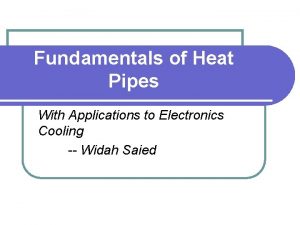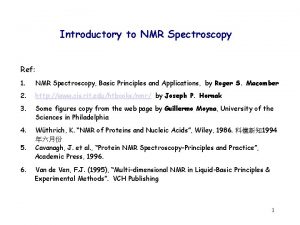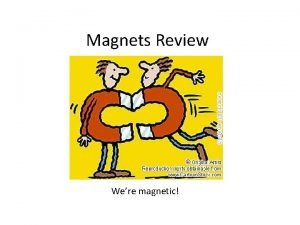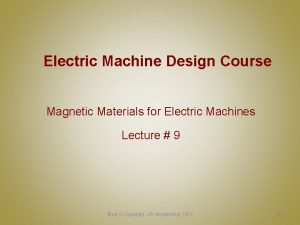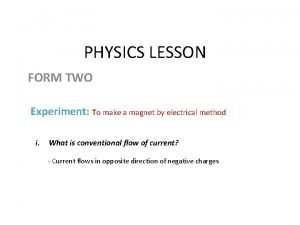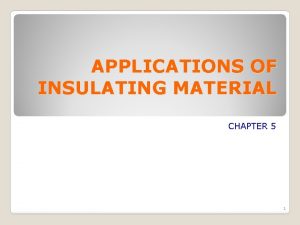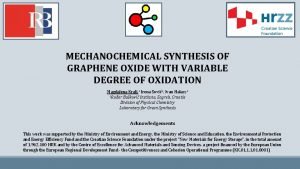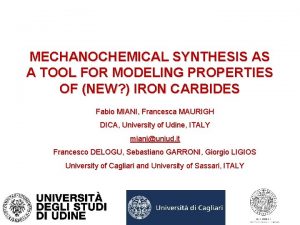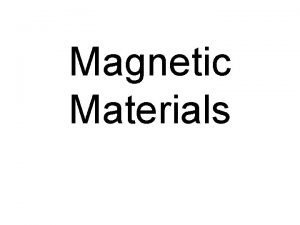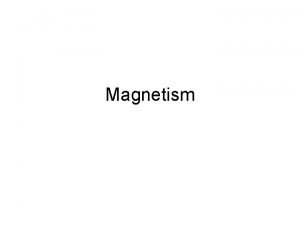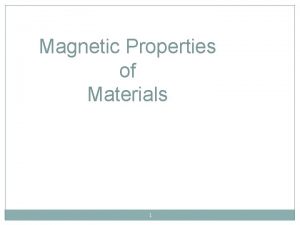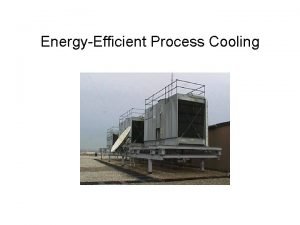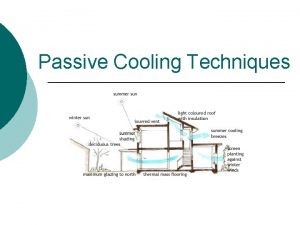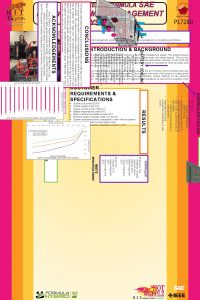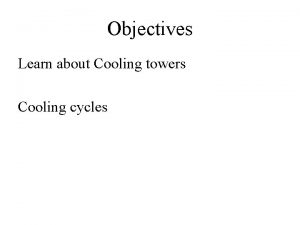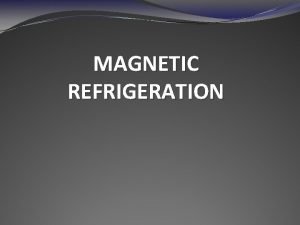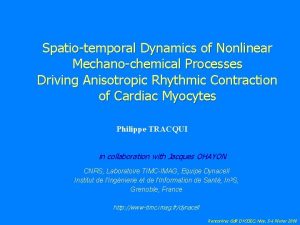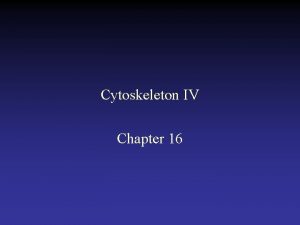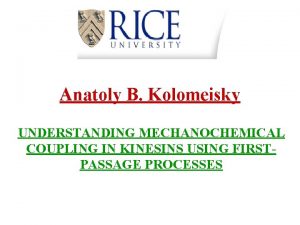Mechanochemical Synthesis NOVEL MATERIALS FOR MAGNETIC COOLING APPLICATIONS














- Slides: 14

Mechanochemical Synthesis: NOVEL MATERIALS FOR MAGNETIC COOLING APPLICATIONS Viktor P. Balema Ames Laboratory of US Dept. of Energy Ames, Iowa, USA This presentation does not contain any proprietary or unpublished information.

Solid-State Caloric Technology Apply Field T T + DT Novel Materials & Systems for improved cooling efficiency between RT and 4 K m 0 m Cooling T - DT H 2 M H 1 d. H Heating H Remove Field v Metals & Alloys v Complex Oxides & Ceramics v Hybrid 3 D Network Materials T Industrial Drivers v Magnetic field v Electric field v Mechanical Force Commercial Residential

Caloric vs. Conventional Technology DT (K) Efficiency COP/ COPCarnot Environmental impact Cost Ref. Vapor-compress. >20 ~60% High Low 1 Thermoelectric ~30 10% Low Medium 2 Thermoacoustic ~10 40% Low Medium 3 Magnetocaloric ~40 ~70%* Low High/Med. 4 Elastocaloric ~20 ~80%* Low High/Med. 5 Electrocaloric ~13 Unkn. Low High/Med. 6 * Estimated based on materials performance; **Estimated based on performance of magnetocaloric and elastocaloric materials. 1. The Canadian Renewable Energy Network Report “Commercial Earth Energy System” (CANMET Energy Technology Centre-Varennes, CANETA Research & TECHNOSIM Consulting Group For Renewable and Electrical Energy Division, Natrual Resources of Canada, 2009 ). 2. TE Technology, Inc. , Technical Information (http: //www. tetech. com/, 2010); Snyder, G. J. & Ursell, T. S. Phys. Rev. Lett. 91(14), 148301 (2003). 3. Backhaus, S. & Swift, G. W. Nature 399, 335 -338 (1999); Garrett, S. L. Am. J. Phys. 72, 11 -17 (2004). 4. Gschneidner, K. A. & Pecharsky, V. K. Annu. Rev. Mater. Sci. 30, 387 -429 (2000); Hall, J. L. & Barclay, J. A. Adv. Cryog. Eng. 43, 17191728(1998). 5. Jun Cui et al. Appl. Phys. Lett. 101, 073904 (2012); Gall, K. et al. Mat. Sci. Eng. a-Struct. 317, 85 -92 (2001). 6. Neese, B. et al. Science 321, 821 (2008); Mischenko, A. S. et al. Science 311, 1270 -1271 (2006).

Calori. Cool – Revolutionary Cooling Technology Foundational to Applied Discovery Development Scale-up Manufacturing Material development System development Design Validation Economics Application Applied to Foundational

Magnetocaloric Materials Cryogenic Cooling • • High values of −∆SM max Tm appropriate for cryogenic cooling Tunable interatomic distances Substantial surface (contact) areas Compound Tm (K) −∆SM max (J kg− 1 K− 1) Organic Salts Gd(HCO 2)3 2. 0 55 (7 T) Gd(CH 3 COO)3· 4 H 2 O 1. 2 40 (7 T) [Gd(C 4 O 4)(C 2 O 4)]· 0. 5 H 2 O 2 30 44 (7 T) {[Gd 2(ida)3]· 2 H 2 O}x 2. 0 40 (7 T) [Gd 36(NA)36(OH)49(O)6]x 3. 0 40 (7 T) {[Gd 2(OH)2 (suc)2]·H 2 O}x 1. 8 43 (7 T) MOFs H(NA ) = nicotinic acid H 2 (ida) = iminodiacetic acid H 2 (suc) = succinic acid Y-Zh. Zheng et al. Chem. Soc. Rev. 2014, 43, 1462; R. Sibille et al. APL Mater. 2, 124402 (2014) Gd 2(C 2 O 4)3(H 2 O)6·(0. 6 H 2 O)

Liquid-Free MOF Synthesis Y-MOF (MIL-78 structure) MIL-78 • No liquid eutectics or melting • No liquid by-products • No solvents added N Singh, M. Hardi, V. P. Balema, Chem. Commun. , 49, 972 (2013)

Magnetocaloric Materials Cryogenic Cooling MIL- 78 Gd 2(C 2 O 4)3 • x. H 2 O • Solvent-free milling produces materials with a substantial magnetocaloric effect • Materials’ features ü Short range magnetic ordering below 20 K ü No long range ordering above 2 K ü Week antiferromagnetic interactions below 2 K • Performance is comparable with the best performing materials . N. K. Singh, V. P. Balema et al. J. Alloys and Compds, , 696, 118 (2017).

Mechanochemistry Ph 3 P-CH 2 -R 1 X Ball-milling no solvents room temperature • Different materials • Similar results • Complex metal hydrides and oxides • Composites, incl. polymer-based • Metal alloys • 2 D materials • Polymers V. Balema et al. J. Am. Chem. Soc. 124, 6244 (2002); Chem. Commun. 1606 (2002); New J. Chem. 34, 25 (2010); . J. Alloys Compds. 313, 69(2000); M. Mamathab et al. J. Alloys Compds, 407, 7 (2006); K. Chlopek et al. J. Mat. Chem. 17, 3496 (2007); H. Brinks et al. J. Phys. Chem. 110, 25833 (2006); V. Volkov et al. Inorg. Chim. Acta 289, 51(1999);

Mechanochemistry How it Happens? Is temperature a factor? V. P. Balema in Materials Challenges in Alternative Energy, Wiley, 2011, p. 25; C. C. Koch, Int. J. Mechanochem. Mech. Alloying 1, 56 (1994) Maurice, et al. Metall. Trans. A 21 A, 289 (1990 ); Metall. Trans. A 26 A, 2432 (1995); Metall. Trans. A 27 A, 1981 (1996 ); F. Fisher et al. , Org. Prog. Res. Dev. 21, 655 (2017); H. Kulla et ai. , Chem. Commun. 53, 1664 (2017).

Mechanochemistry How it Happens? Sta d e bl g n i ur l i m ! g lin (NH 4)2 CO 3 13 C (NH 4)2 CO 3 MAS NMR DTA ball-milled for 20 h exo as is endo ball-milled for 20 h NH 2(NH 4)CO 2 TGA CO 2 as is Dm 50 100 150 Temperature C o 200 250 V. P. Balema et al. Phys. Chem. Phys. 7, 1310 (2005); Komatsu, K. Top. Curr. Chem. 254, 185 (2005) 200 150 ppm 100

Mechanochemistry How it Happens? Severe deformations are probable drivers of chemical transformations observed Mg + H 2 = Mg. H 2 Bridgeman’s anvil Material: diamond or boron nitride Pressure: up to 10 GPa H 2 absorption by Mg: as-received, cold rolled and ball-milled; 623 K, 2 MPa H 2 J. Hout, V. P. Balema, Material Matters 5 (4), 112 (2010). A. Zharov in High Pressure Chemistry and Physics of Polymers, Ed. : A. L. Kovarskii, CRC Press, Boca Raton, 1994, 267 p. ; A. Politov et al. Doklady Phys. Chem. 371, 28 (2000)

Mechanochemistry How it Happens? Plastic Deformations LAG V. P. Balema in Materials Challenges in Alternative Energy, Wiley, 2011, p. 25

Takeaways • Gd–based 3 D hybrid networks are promising materials for Magnetic Refrigeration at cryogenic temperatures • Mechanochemistry offers a simple and scalable way of making hybrid magnetocaloric materials • Severe plastic deformations are probably responsible for the formation of REE MOF structures upon mechanical milling without solvents.

Acknowledgment Ames Laboratory of US DOE • • • Vitalij Pecharsky Alexander Dolotko Yaroslav Mudryk Marek Prusk Shalabh Gupta Sigma-Aldrich (now Millipore. Sigma) • Niraj Singh • Samuel Taylor Calori. Cool. TM is supported by the Advanced Manufacturing Office of the Office of Energy Efficiency & Renewable Energy and managed jointly through the Advanced Manufacturing and Building Technologies Offices of the U. S. Department of Energy. Ames Laboratory is operated for the U. S. Department of Energy by Iowa State University of Science and Technology under Contract No. DE-AC 02 -07 CH 11358. Initial work was supported by Aldrich Hard Materials, Sigma-Aldrich Corporation.
 Types of heat pipes
Types of heat pipes Novel data science applications
Novel data science applications Magnetic force particle
Magnetic force particle Magnetic retentivity
Magnetic retentivity Units of magnetic flux density
Units of magnetic flux density Magnetic moment and magnetic field relation
Magnetic moment and magnetic field relation Application of nmr
Application of nmr Q factor of capacitor
Q factor of capacitor Whats a magnet
Whats a magnet Magnetic materials used in electrical machines
Magnetic materials used in electrical machines Distinguish between magnetic and nonmagnetic materials
Distinguish between magnetic and nonmagnetic materials Solid insulating materials and their applications
Solid insulating materials and their applications Classification of insulating materials
Classification of insulating materials Direct materials budget with multiple materials
Direct materials budget with multiple materials Favourite cars
Favourite cars
